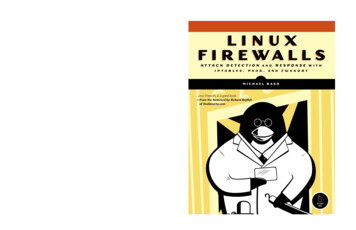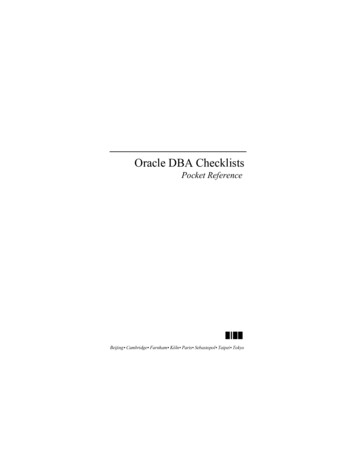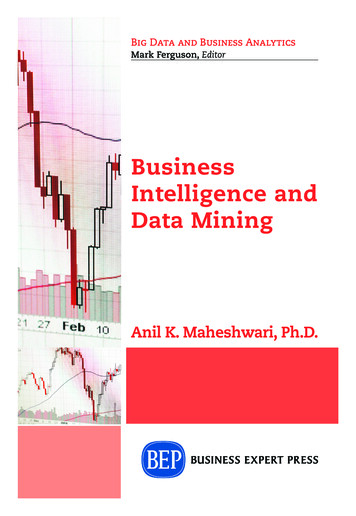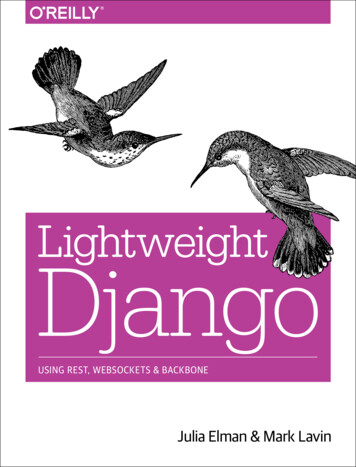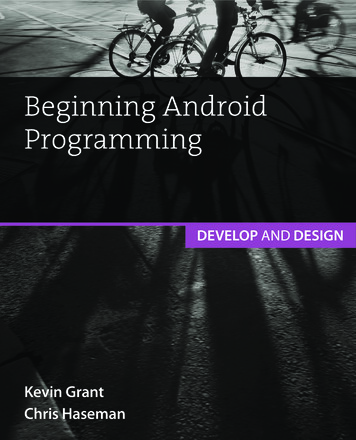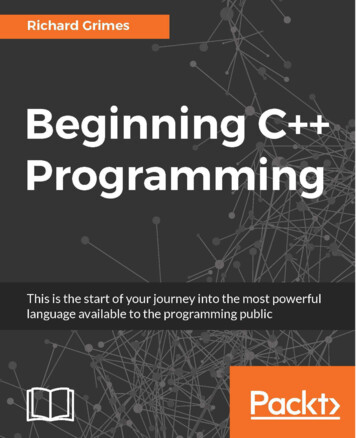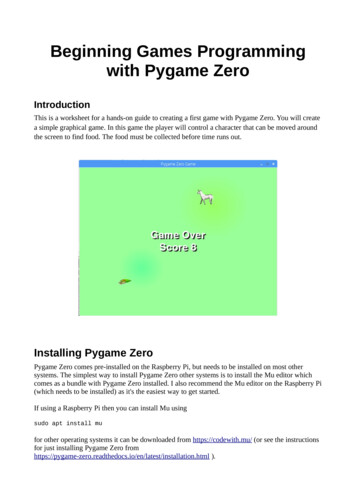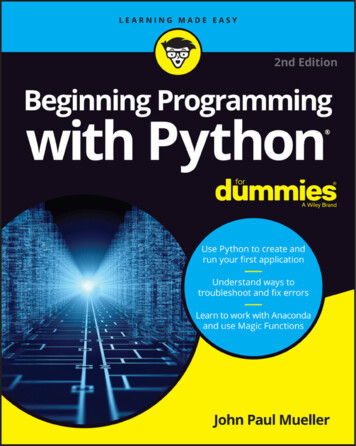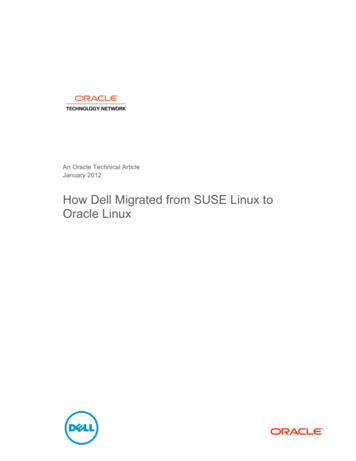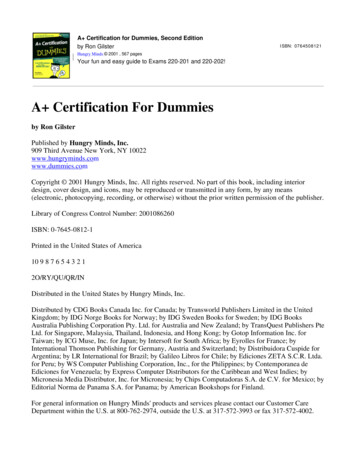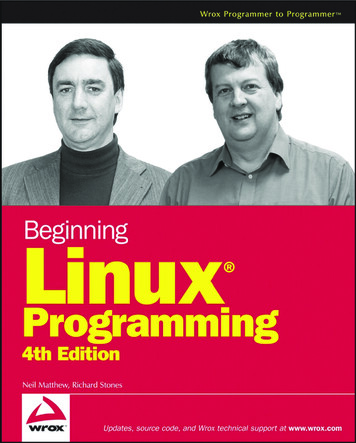
Transcription
47627ffirs.qxd:WroxPro10/1/077:07 AMPage vBeginningLinux Programming4th EditionNeil MatthewRichard StonesWiley Publishing, Inc.
47627ffirs.qxd:WroxPro10/1/077:07 AMPage ii
47627ffirs.qxd:WroxPro10/1/077:07 AMPage iBeginning Linux Programming 4th EditionAcknowledgements . . . . . . . . . . . . . . . . . . . . . . . . . . . . . . . . . . . . . . . . . . . . xForeword. . . . . . . . . . . . . . . . . . . . . . . . . . . . . . . . . . . . . . . . . . . . . . . . . . xxiiiIntroduction . . . . . . . . . . . . . . . . . . . . . . . . . . . . . . . . . . . . . . . . . . . . . . . . xxvChapter 1: Getting Started . . . . . . . . . . . . . . . . . . . . . . . . . . . . . . . . . . . . . . 1Chapter 2: Shell Programming . . . . . . . . . . . . . . . . . . . . . . . . . . . . . . . . . . . 17Chapter 3: Working with Files . . . . . . . . . . . . . . . . . . . . . . . . . . . . . . . . . . . 93Chapter 4: The Linux Environment . . . . . . . . . . . . . . . . . . . . . . . . . . . . . . . 137Chapter 5: Terminals . . . . . . . . . . . . . . . . . . . . . . . . . . . . . . . . . . . . . . . . . 175Chapter 6: Managing Text-Based Screens with curses . . . . . . . . . . . . . . . . 211Chapter 7: Data Management . . . . . . . . . . . . . . . . . . . . . . . . . . . . . . . . . . 255Chapter 8: MySQL . . . . . . . . . . . . . . . . . . . . . . . . . . . . . . . . . . . . . . . . . . . 311Chapter 9: Development Tools . . . . . . . . . . . . . . . . . . . . . . . . . . . . . . . . . . 377Chapter 10: Debugging . . . . . . . . . . . . . . . . . . . . . . . . . . . . . . . . . . . . . . . 429Chapter 11: Processes and Signals . . . . . . . . . . . . . . . . . . . . . . . . . . . . . . 461Chapter 12: POSIX Threads . . . . . . . . . . . . . . . . . . . . . . . . . . . . . . . . . . . . 495Chapter 13: Inter-Process Communication: Pipes . . . . . . . . . . . . . . . . . . . . 525Chapter 14: Semaphores, Shared Memory, and Message Queues. . . . . . . . . 577Chapter 15: Sockets . . . . . . . . . . . . . . . . . . . . . . . . . . . . . . . . . . . . . . . . . 607Chapter 16: Programming GNOME Using GTK . . . . . . . . . . . . . . . . . . . . . . 645Chapter 17: Programming KDE Using Qt. . . . . . . . . . . . . . . . . . . . . . . . . . . 701Chapter 18: Standards for Linux. . . . . . . . . . . . . . . . . . . . . . . . . . . . . . . . . 747Index . . . . . . . . . . . . . . . . . . . . . . . . . . . . . . . . . . . . . . . . . . . . . . . . . . . . 761
47627ffirs.qxd:WroxPro10/1/077:07 AMPage ii
47627ffirs.qxd:WroxPro10/1/077:07 AMPage iiiBeginningLinux Programming4th Edition
47627ffirs.qxd:WroxPro10/1/077:07 AMPage iv
47627ffirs.qxd:WroxPro10/1/077:07 AMPage vBeginningLinux Programming4th EditionNeil MatthewRichard StonesWiley Publishing, Inc.
47627ffirs.qxd:WroxPro10/1/077:07 AMPage viBeginning Linux Programming, 4th EditionPublished byWiley Publishing, Inc.10475 Crosspoint BoulevardIndianapolis, IN 46256www.wiley.comCopyright 2008 by Wiley Publishing, Inc., Indianapolis, IndianaPublished simultaneously in CanadaISBN: 978-0-470-14762-7Manufactured in the United States of America10 9 8 7 6 5 4 3 2 1Library of Congress Cataloging-in-Publication Data is available from the publisher.No part of this publication may be reproduced, stored in a retrieval system or transmitted in any form orby any means, electronic, mechanical, photocopying, recording, scanning or otherwise, except as permitted under Sections 107 or 108 of the 1976 United States Copyright Act, without either the prior writtenpermission of the Publisher, or authorization through payment of the appropriate per-copy fee to theCopyright Clearance Center, 222 Rosewood Drive, Danvers, MA 01923, (978) 750-8400, fax (978) 646-8600.Requests to the Publisher for permission should be addressed to the Legal Department, Wiley Publishing,Inc., 10475 Crosspoint Blvd., Indianapolis, IN 46256, (317) 572-3447, fax (317) 572-4355, or online athttp://www.wiley.com/go/permissions.LIMIT OF LIABILITY/DISCLAIMER OF WARRANTY: THE PUBLISHER AND THE AUTHORMAKE NO REPRESENTATIONS OR WARRANTIES WITH RESPECT TO THE ACCURACY ORCOMPLETENESS OF THE CONTENTS OF THIS WORK AND SPECIFICALLY DISCLAIM ALLWARRANTIES, INCLUDING WITHOUT LIMITATION WARRANTIES OF FITNESS FOR APARTICULAR PURPOSE. NO WARRANTY MAY BE CREATED OR EXTENDED BY SALES ORPROMOTIONAL MATERIALS. THE ADVICE AND STRATEGIES CONTAINED HEREIN MAY NOTBE SUITABLE FOR EVERY SITUATION. THIS WORK IS SOLD WITH THE UNDERSTANDINGTHAT THE PUBLISHER IS NOT ENGAGED IN RENDERING LEGAL, ACCOUNTING, OR OTHERPROFESSIONAL SERVICES. IF PROFESSIONAL ASSISTANCE IS REQUIRED, THE SERVICES OF ACOMPETENT PROFESSIONAL PERSON SHOULD BE SOUGHT. NEITHER THE PUBLISHER NORTHE AUTHOR SHALL BE LIABLE FOR DAMAGES ARISING HEREFROM. THE FACT THAT ANORGANIZATION OR WEBSITE IS REFERRED TO IN THIS WORK AS A CITATION AND/OR APOTENTIAL SOURCE OF FURTHER INFORMATION DOES NOT MEAN THAT THE AUTHOR ORTHE PUBLISHER ENDORSES THE INFORMATION THE ORGANIZATION OR WEBSITE MAYPROVIDE OR RECOMMENDATIONS IT MAY MAKE. FURTHER, READERS SHOULD BE AWARETHAT INTERNET WEBSITES LISTED IN THIS WORK MAY HAVE CHANGED OR DISAPPEAREDBETWEEN WHEN THIS WORK WAS WRITTEN AND WHEN IT IS READ.For general information on our other products and services please contact our Customer CareDepartment within the United States at (800) 762-2974, outside the United States at (317) 572-3993 orfax (317) 572-4002.Trademarks: Wiley, the Wiley logo, Wrox, the Wrox logo, Wrox Programmer to Programmer, andrelated trade dress are trademarks or registered trademarks of John Wiley & Sons, Inc. and/or its affiliates, in the United States and other countries, and may not be used without written permission. Linuxis a trademark of Linus Torvalds. All other trademarks are the property of their respective owners.Wiley Publishing, Inc., is not associated with any product or vendor mentioned in this book.Wiley also publishes its books in a variety of electronic formats. Some content that appears in printmay not be available in electronic books.
47627ffirs.qxd:WroxPro10/1/077:07 AMPage viiAbout the AuthorsNeil Matthew has been interested in and has programmed computers since 1974. A mathematicsgraduate from the University of Nottingham, Neil is just plain keen on programming languagesand likes to explore new ways of solving computing problems. He’s written systems to program inBCPL, FP (Functional Programming), Lisp, Prolog, and a structured BASIC. He even wrote a 6502microprocessor emulator to run BBC microcomputer programs on UNIX systems.In terms of UNIX experience, Neil has used almost every flavor since the late 1970s, including BSDUNIX, AT&T System V, Sun Solaris, IBM AIX, many others, and of course Linux. He can claim tohave been using Linux since August 1993 when he acquired a floppy disk distribution of SoftLanding (SLS) from Canada, with kernel version 0.99.11. He’s used Linux-based computers forhacking C, C , Icon, Prolog, Tcl, and Java at home and at work.All of Neil’s “home” projects are developed using Linux. He says Linux is much easier because itsupports quite a lot of features from other systems, so that both BSD- and System V-targeted programs will generally compile with little or no change.Neil is currently working as an Enterprise Architect specializing in IT strategy at Celesio AG. Hehas a background in technical consultancy, software development techniques, and quality assurance. Neil has also programmed in C and C for real-time embedded systems.Neil is married to Christine and has two children, Alexandra and Adrian. He lives in a convertedbarn in Northamptonshire, England. His interests include solving puzzles by computer, music,science fiction, squash, mountain biking, and not doing it yourself.Rick Stones started programming at school (more years ago than he cares to remember) on a6502-powered BBC micro, which, with the help of a few spare parts, continued to function for thenext 15 years. He graduated from Nottingham University with a degree in Electronic Engineering,but decided software was more fun.Over the years he has worked for a variety of companies, from the very small with just a dozenemployees, to the very large, including the IT services giant EDS. Along the way he has worked ona range of projects, from real-time communications to accounting systems, to very large help desksystems. He is currently working as an IT architect, acting as a technical authority on various majorprojects for a large pan-European company.A bit of a programming linguist, he has programmed in various assemblers, a rather neat proprietarytelecommunications language called SL-1, some FORTRAN, Pascal, Perl, SQL, and smidgeons ofPython and C , as well as C. (Under duress he even admits that he was once reasonably proficientin Visual Basic, but tries not to advertise this aberration.)Rick lives in a village in Leicestershire, England, with his wife Ann, children Jennifer and Andrew,and a cat. Outside work his main interests are classical music, especially early religious music, andphotography, and he does his best to find time for some piano practice.
47627ffirs.qxd:WroxPro10/1/077:07 AMPage viii
47627ffirs.qxd:WroxPro10/1/077:07 AMPage ixCreditsAcquisitions EditorVice President and Executive Group PublisherJenny WatsonRichard SwadleyDevelopment EditorVice President and Executive PublisherSara ShlaerJoseph B. WikertTechnical EditorProject Coordinator, CoverTimothy BoronczykAdrienne MartinezProduction EditorGraphics and Production SpecialistsWilliam A. BartonMike Park, Happenstance-Type-O-RamaCraig Woods, Happenstance-Type-O-RamaCopy EditorKim CoferProofreaderAmy McCarthy, Word OneEditorial ManagerMary Beth WakefieldIndexerJohnna VanHoose DinseProduction ManagerTim TateAnniversary Logo DesignRichard Pacifico
47627ffirs.qxd:WroxPro10/1/077:07 AMPage xAcknowledgmentsThe authors would like to record their thanks to the many people who helped to make thisbook possible.Neil would like to thank his wife, Christine, for her understanding and children Alex and Adrianfor not complaining too loudly at Dad spending so long in The Den writing.Rick would like to thank his wife, Ann, and their children, Jennifer and Andrew, for their very considerable patience during the evenings and weekends while Dad was yet again “doing book work.”As for the publishing team, we’d like to thank the folks at Wiley who helped us get this fourth editioninto print. Thanks to Carol Long for getting the process started and sorting out the contracts, andespecially to Sara Shlaer for her exceptional editing work and Timothy Boronczyk for his excellenttechnical reviews. We also wish to thank Jenny Watson for chasing down all those odd bits of extrasand generally guiding the book through the administrative layers, Bill Barton for ensuring properorganization and presentation, and Kim Cofer for a thorough copyedit. We are very grateful also toEric Foster-Johnson for his fantastic work on Chapters 16 and 17. We can say that this is a better bookthan it would have been without the efforts of all of you.We would also like to thank our employers, Scientific Generics, Mobicom, and Celesio for theirsupport during the production of all four editions of this book.Finally we would also like to pay homage to two important motivators who have helped make thisbook possible. Firstly, Richard Stallman for the excellent GNU tools and the idea of a free softwareenvironment, which is now a reality with GNU/Linux, and secondly, Linus Torvalds for starting andcontinuing to inspire the co-operative development that gives us the ever-improving Linux kernel.
47627ftoc.qxd:WroxPro10/1/077:11 AMPage ter 1: Getting StartedAn Introduction to UNIX, Linux, and GNUWhat Is UNIX?What Is Linux?The GNU Project and the Free Software FoundationLinux DistributionsProgramming LinuxLinux ProgramsText EditorsThe C CompilerDevelopment System RoadmapGetting HelpSummaryxxxiiixxv111334456781416Chapter 2: Shell Programming17Why Program with a Shell?A Bit of PhilosophyWhat Is a Shell?Pipes and Redirection18181921Redirecting OutputRedirecting InputPipesThe Shell as a Programming LanguageInteractive ProgramsCreating a ScriptMaking a Script ExecutableShell SyntaxVariablesConditionsControl StructuresFunctionsCommandsCommand Execution2122222323242527273134464968
47627ftoc.qxd:WroxPro10/1/077:11 AMPage xiiContentsHere DocumentsDebugging ScriptsGoing Graphical — The dialog UtilityPutting It All TogetherRequirementsDesignSummaryChapter 3: Working with Files758182829193Linux File Structure94DirectoriesFiles and Devices9495System Calls and Device DriversLibrary FunctionsLow-Level File AccesswritereadopenInitial PermissionsOther System Calls for Managing Files9697989899100101106The Standard I/O Library109fopenfreadfwritefclosefflushfseekfgetc, getc, and getcharfputc, putc, and putcharfgets and gets110110111111111112112112113Formatted Input and Output113printf, fprintf, and sprintfscanf, fscanf, and sscanfOther Stream FunctionsStream ErrorsStreams and File Descriptors113115117119119File and Directory Maintenance120chmodchownunlink, link, and symlinkmkdir and rmdirchdir and getcwdxii7374120120121121122
47627ftoc.qxd:WroxPro10/1/077:11 AMPage xiiiContentsScanning orsstrerrorperrorThe /proc File SystemAdvanced Topics: fcntl and 33Summary135Chapter 4: The Linux EnvironmentProgram Argumentsgetoptgetopt longEnvironment VariablesUse of Environment VariablesThe environ VariableTime and DateTemporary FilesUser InformationHost InformationLoggingResources and LimitsSummaryChapter 5: TerminalsReading from and Writing to the TerminalTalking to the TerminalThe Terminal Driver and the General Terminal InterfaceOverviewHardware ModelThe termios StructureInput ModesOutput ModesControl ModesLocal 17518018218318318418
Eric Foster-Johnson for his fantastic work on Chapters 16 and 17. We can say that this is a better book than it would have been without the efforts of all of you. We would also like to thank our employers, Scientific Generics, Mobicom, and Celesio for their support during
